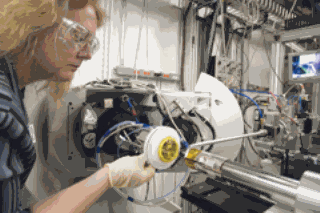What could have been a shattering let-down for NASA’s Genesis Discovery Mission has become an opportunity for synchrotron light source science to shine. NASA’s Genesis Discovery Mission was a space probe that went out beyond Earth’s atmosphere to capture solar wind from our Sun. Kathy Kitts (Northern Illinois University), a Genesis Science Team member, explained the mission and the evolution of the studies she is carrying out at the University of Chicago’s GeoSoilEnviroCARS Sector 13 beamline at the Advanced Photon Source (APS) at the U.S. Department of Energy’s Argonne National Laboratory.
“As the Sun evaporates, the evaporation produces solar wind, and studying the composition of solar wind gives us the perfect resources for determining precisely what the Sun is made of,” said Kitts. “These studies are important because they will give us a baseline for developing an understanding of how the solar system has evolved over time and how solar processes and solar wind mechanics behave. We can get a spectrum from the Sun, but we want the absolute details about the abundances of elements in the Sun. We know the Sun is made up of everything in our solar system (mostly hydrogen and helium), so if we know what the Sun is composed of, then we have a baseline for the composition of the solar system.
“The capture mechanisms used in the Genesis Discovery Mission were 10-cm hexagon wafers of sapphire, silicon, and germanium. When the probe encountered the solar wind, it deployed these wafers as detectors and collected a wide range of elements. With different detectors made of different materials, we can look for different things. So for instance, in the germanium wafer, one would not look for germanium because the signal would be undetectable.
“Unfortunately, when the probe came back to Earth exactly on time at exactly the right place, a component problem told the probe that it was falling up, not down, and so it did not deploy its parachute. When the probe impacted in the Utah desert, the hexagons shattered into tiny pieces, from about 2-cm by 1-cm down to microscopic. The shards we’re examining at Sector 13 are aluminum on sapphire and silicon on sapphire. The APS and the GSECARS facility are the only ones at present that will enable studies of these tiny wafer fragments, thanks to the x-ray beam brightness. We are skimming the x-ray beam along the flat surface of the wafers at an angle of nearly zero degrees, using the grazing incidence x-ray diffraction technique. This way, we highlight the residue deposited on the top of the shards. When we very slightly change the angle of the sample relative to the x-ray beam, we can see the solar wind material that’s trapped inside the detector shard. And straight up-and-down (at 90 degrees), we can see the background of the detector material itself. In this way, we can determine where the material from the solar wind is, how much of it there is, how deep it is, and what it is.
“There are other techniques and other collectors being studied, but we’re looking at the transition metals—calcium through nickel and germanium. In that way, we can look at the sections of the Periodic Table that other techniques have not been able to do very well.”
Use of the Advanced Photon Source is supported by the U.S. Department of Energy, Office of Science, Office of Basic Energy Sciences under Contract No. DE-AC02-06CH11357.
Argonne National Laboratory brings the world's brightest scientists and engineers together to find exciting and creative new solutions to pressing national problems in science and technology. The nation's first national laboratory, Argonne conducts leading-edge basic and applied scientific research in virtually every scientific discipline. Argonne researchers work closely with researchers from hundreds of companies, universities, and federal, state and municipal agencies to help them solve their specific problems, advance America 's scientific leadership and prepare the nation for a better future. With employees from more than 60 nations, Argonne is managed by UChicago Argonne, LLC for the U.S. Department of Energy's Office of Science.

